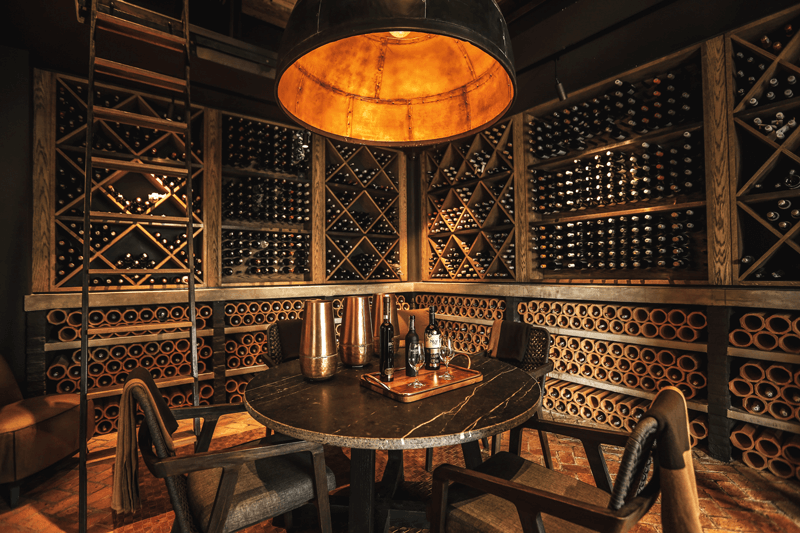For true wine lovers, it is essential to organise a perfect Wine Cellar, where to keep their tasty treasures, so that they can remain intact and even improve over the years.

Why it is important to create a perfect Wine Cellar
Finally you got that precious red wine that you have been dreaming of for a long time, such as those included in this precious list. Maybe you bought it thinking about a future special moment, in which to uncork it and enjoy it. An anniversary, a work goal achieved, a unique occasion. That situation that must be immortalized with a special wine.
Now that you have the wine at hand, the first objective is to keep it safe until it is time to open it. Even great wines, if stored in the wrong way, can get ruined, to the detriment of their excellence. Sudden changes in temperature, excessive heat, prolonged exposure to the sun or violent lighting can easily damage the precious contents of the bottles.
What to do to save your most precious wine bottles? Easy! Just organise a perfect wine cellar.
Read on to find out how to best organize it.

The perfect Wine Cellar: the Basics
To organize a perfect Wine Cellar and preserve all the quality of great aging wines, it is necessary to take into account the following factors:

- Light and Illumination: nothing damages wine more than direct exposure to sunlight. This is why the bottles of the aging wines are thick and in dark glass. Therefore the perfect wine cellar must be well protected from light. This is why the wine shops, especially in the hot hours, use special heavy curtains, precisely to protect the bottles on display, even those that are not for aging. Even the artificial lighting of the cellar must be soft, with low-power lamps and never neon, always to avoid premature oxidation of the wine.
- Temperature: the ideal temperature of a wine cellar is between 11°C/52 °F and 15°C/60 °F and it is important that it remains constant. In fact, sudden changes in temperature are the number one enemy in wine conservation. Therefore, the perfect wine cellar must be equipped with a thermometer, in order to check the room temperature.
- Relative humidity: why are the perfect wine cellars often built underground and have stone or brick walls? To keep costant the relative humidity of the room, which should oscillate between 65% and 70%. A too low relative humidity, below 50%, could speed up the deterioration of the corks and thus accelerate the oxidation of the wine. This is why the hygrometer is a tool always present in the wine cellar .
- Vibrations: the perfect wine cellar should not be located near noisy service areas or roads subject to continuous vibrations. In fact, frequent jolts can damage the products, even just by putting back into suspension those sediments that have naturally deposited during ageing.
- Smells: To keep intact the qualities of the wines, it is advisable to use the cellar for the storage of wines only. Other foods, such as meat and cured meats, should be left to mature in another place, separate from the wines. Likewise, the perfect wine cellar must not house boilers, stoves, fireplaces, for reasons of odors and heat.
The perfect Wine Cellar: how to organize the Wines
Given the basic environmental conditions of the perfect wine cellar, let’s see how to organize the wines that you want to maintain and age in style. Just four steps:

- The bottles will be placed horizontally, on shelves preferably made of wood, a material capable of dampening any vibrations and which also functions as a thermal insulator.
On the lower shelves will be placed the sparkling wines and champagnes and, going up, the whites, the rosés and, finally, the aging reds. This arrangement, from bottom to top, follows the slight variation of the temperature, slightly lower at the basement. Sparkling and white wines prefer storage at lower temperatures than red wines. - If many bottles are kept, it is advisable to separate them on the basis of wine style or country of origin, just to speed up the searching process. Maybe you’re busy and ask a friend of yours to get you a wine in the cellar… so you’ll make life easier for him, without requiring him a master’s degree in survival techniques.
- Finally, for a perfect organization of the cellar, it is good to equip each bottle with a special label. In fact, in the event that the original wine label gets damaged, the one added, perhaps to the neck of the bottle, will help you easily identify the product, without taking it off the shelf.
- Keep your day-by-day wines on a separate shelf, so they are immediately at hand. Those are the ones you will finish first!
Refrigerated Wine Cellar
If you have a few bottles of wine to let age and you don’t have a suitable environment for storing great aging wines, sometimes the best solution is to purchase a refrigerated wine cellar .
These particular cellar, often equipped with a beautiful design and the possibility of being built into living room or kitchen furniture, allow an excellent conservation of all wines: sparkling, whites, rosés and reds.
These modern cellars have an adjustable temperature, which ranges from 5° to 20°, and often also have an internal subdivision, with zones at different temperatures.
Therefore, in a cellar like this it is possible to store sparkling wines and whites to be consumed in a short time and, at the same time, keep aging reds to evolve through years.
These particular pieces of furniture, made of stainless materials and equipped with UV filter glass, have perfect ventilation and excellent insulation: characteristics that protect the wine bottles from vibrations, from the harmful effects of light and humidity.






